Birds
Media

Species Types
Scientific Name
Euphagus carolinus
Description
Missourians most often see rusty blackbirds during spring and fall migration, though in southern Missouri they sometimes stay through the winter. Look for them foraging in pastures and fields near water.
Media

Species Types
Scientific Name
Cathartes aura
Description
The turkey vulture is perhaps the most commonly seen soaring bird in our state. Identify this "buzzard" from below by its shallow V-angled wing posture and two-toned pattern, with the forward edge of the wings black and the trailing half gray or silvery.
Media
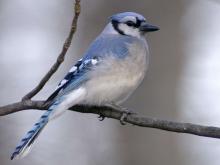
Species Types
Scientific Name
Cyanocitta cristata
Description
Blue jays are notable for their loud voices, blue and white plumage, strong black bill, relatively large size and the distinctive crest atop their heads.
Media

Species Types
Scientific Name
Podiceps auritus
Description
Horned grebes are small ducklike birds that may be seen in Missouri during migration and locally in the winter. Breeding coloration is different from that of winter.
Media
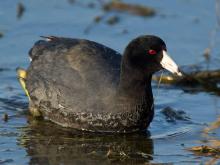
Species Types
Scientific Name
Fulica americana
Description
Although it floats like a duck, the American coot is actually in the rail family. Note its short tail and wings, pointed white bill, chickenlike walk, and toes with scalloped lobes.
Media
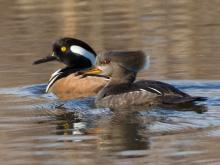
Species Types
Scientific Name
Lophodytes cucullatus
Description
Hooded mergansers have crests that trail behind the head or can be raised to create a circular shape. Their bills are narrow and serrated. Males are black and white with chestnut flanks; females are brown.
Media
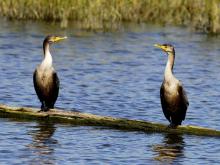
Species Types
Scientific Name
Phalacrocorax auritus
Description
Double-crested cormorants are dark, ducklike water birds with long necks, hooked bills, legs set far back on the body, and a habit of hanging their wings out to dry in the sun.
Media
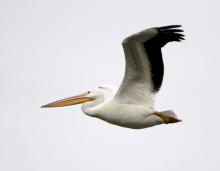
Species Types
Scientific Name
Pelecanus erythrorhynchos
Description
Graceful in flight, ungainly on land, and elegant on the water, the American white pelican is one of the largest birds in Missouri.
Media

Species Types
Scientific Name
Sternula antillarum
Description
The least tern is gull-like, gray above and white below. The head has a black cap and nape, and a white forehead. The bill is bright yellow and its sharp tip is black. The tail is deeply forked. Look for it along big rivers April–September.
Media
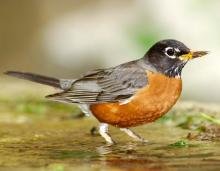
Species Types
Scientific Name
Turdus migratorius
Description
A well-known symbol of springtime, this bird hunts on the ground for earthworms and insects. The robin’s colorful rusty-red breast is as welcome in spring as its cheerful singing at dawn and dusk.
See Also







Media

Species Types
Scientific Name
Hemaris diffinis
Description
The snowberry clearwing is a moth that confuses people because it looks like a bumblebee and flies like a hummingbird!
Media

Species Types
Scientific Name
Hyles lineata
Description
The white-lined sphinx moth sometimes confuses people because it flies, hovers, and eats from flowers like a hummingbird. The adults often fly during daylight hours as well as in the night and are often found at lights.
Media

Species Types
Scientific Name
Darapsa myron
Description
The Virginia creeper sphinx moth is common in woods and brushy areas and comes to lights at night. The larvae eat Virginia creeper and grape leaves.
Media

Species Types
Scientific Name
Perimyotis subflavus (formerly Pipistrellus subflavus)
Description
Tri-colored bats, formerly called eastern pipistrelles, are relatively small and look pale yellowish or pale reddish brown. The main hairs are dark gray at the base, broadly banded with yellowish brown, and tipped with dark brown.
Media

Species Types
Scientific Name
Myotis grisescens
Description
Gray myotises are difficult to distinguish from other mouse-eared bats. A key identifying feature of the gray myotis is that its wing is attached to the ankle and not at the base of the toes. It’s an endangered species.
Media

Species Types
Scientific Name
Myotis lucifugus
Description
The little brown myotis (little brown bat) is one of our most common bats, but populations are declining. White-nose syndrome has taken a heavy toll in northeastern states. This species is now listed as vulnerable across its range.
Media

Species Types
Scientific Name
Myotis sodalis
Description
The Indiana myotis, or Indiana bat, summers along streams and rivers in north Missouri, raising its young under the bark of certain trees. It is an endangered species.
About Birds in Missouri
About 350 species of birds are likely to be seen in Missouri, though nearly 400 have been recorded within our borders. Most people know a bird when they see one — it has feathers, wings, and a bill. Birds are warm-blooded, and most species can fly. Many migrate hundreds or thousands of miles. Birds lay hard-shelled eggs (often in a nest), and the parents care for the young. Many communicate with songs and calls.





















